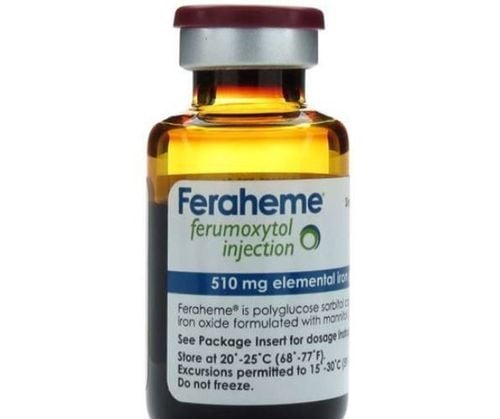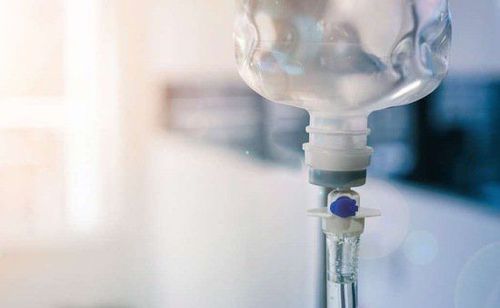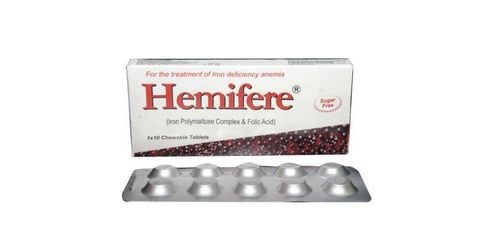This is an automatically translated article.
Iron, an essential nutrient that the body uses to produce hemoglobin, the protein in red blood cells that helps blood carry oxygen to all other cells in the body. Iron is necessary for: Supply of oxygen to the body, muscle metabolism, maintenance of connective tissue, physiological development, nerve development, cell function, production of certain hormones. Breastfed babies usually get enough iron from breast milk, while formula-fed babies are different.
1. Some problems related to iron deficiency anemia in children
When children switch to regular food with food, they may experience a condition where they won't get enough iron. Low iron levels can lead to anemia, in which the number of red blood cells in your body is too low, potentially causing problems with oxygen reaching vital organs.
If your child has low iron levels, which can lead to anemia, then you can rely on some of the following signs to determine:
Pale Children often appear irritable Children do not want to eat In the long term , these symptoms can lead to effects on the child including:
Slower growth Slower development of motor skills Higher number of infections, as iron supports the immune system Symptoms may not appear at first, but over time your child may experience: Fatigue; pale skin; irritability; fast heart rate or arrhythmia; decreased appetite; slow weight gain; dizzy; headache; difficulty concentrating...
Several studies conducted on the association between tea drinking and anemia in children have found that children drinking tea are more likely to be associated with anemia due to anemia. iron . The possible explanation for this phenomenon is that the tannins present in tea reduce the body's ability to absorb iron. Another case is that the child may be too full after drinking tea.
2. Children's iron needs
Iron is an essential mineral for children who are growing rapidly. Therefore, cereals and other foods selected for toddlers will boost the iron content of these foods.
Recommended daily iron requirements will vary by age.
0–6 months: 0.27 milligrams (mg) daily 6-12 months: 11 mg daily 1 year to 3 years: 7 mg daily 4-8 years: 10 mg daily Preterm infants or low birth weight babies often need more iron than babies born with normal weight.

Nhu cầu bổ sung sắt hàng ngày tùy thuộc vào từng độ tuổi và giới tính của trẻ
Heme iron vs non-heme iron
Dietary iron comes in two main forms: heme and non-heme. Plant-based foods often contain non-heme irons. Meat and seafood or foods of animal origin contain both heme and nonheme iron.
The body does not absorb non-heme iron but becomes quite readily with heme iron. This is true for both toddlers and adults. If your child is a vegetarian or mostly vegan, aim to get twice the recommended amount of iron.
The body absorbs iron better when you consume it with a source of vitamin C. To help your body absorb more iron, eat iron-rich foods along with foods rich in vitamin C. Examples of foods rich in vitamin C include: Orange and orange juices; pomelo; Kiwi; broccoli; tomato; strawberry; Bell pepper; papaya; melon; sweet potato
3. Foods that toddlers should use to supplement iron
Feeding your child iron-rich foods along with foods rich in vitamin C can help reduce your child's risk of developing iron deficiency. Foods that are good for children in ensuring the recommended amount of iron include:
3.1. Lean meat Meat and poultry contain a large amount of heme iron, which is easily digested by the body. Beef, organs and liver in particular belong to the food group that contains a lot of iron. For example, an 84-gram serving of beef liver contains 5 mg of iron. Dark chicken and turkey are also good sources.
You can make a toddler stew or casserole with soft cooked lean meat. However, you should be sure to remove the fatty part of the meat as there is very little iron in the fatty portions. Or Spaghetti with meat and tomato sauce is another iron-friendly option.
3.2. Fortified cereals What do anemic children eat? Fortified cereals and oatmeal are a good way to make sure your toddler is getting enough iron.
One serving of iron-fortified cereal typically has 100% of the daily value of iron in just one serving. However, the exact number of foods will vary, so be sure to check the label. Dry cereals, such as Cheerios, are also commonly used to fortify children's iron.
One cup of whole, uncooked rolled oats contains about 3.5 mg of iron.
You can give your toddler breakfast cereal or oatmeal with some blueberries or strawberries for an extra dose of vitamin C.
You should be aware that although fortified cereals and juices are While they can provide extra iron, they are also often high in sugar.

Các loại bột ngũ cốc khô là nguồn tăng cường sắt tuyệt vời cho trẻ bị thiếu máu
3.3. Beans If you're aiming for a vegetarian diet or your child doesn't like meat, beans are a great choice, including: Soybeans, lima beans, kidney beans, lentils, and other legumes and beans Contains a fairly rich content of iron along with fiber, other essential vitamins and minerals. For example:
Half a cup of white beans has 4 mg of iron Half a cup of lentils has 3 mg of iron Half a cup of red beans has 2 mg of iron You can mash some cooked lentils or make a soup or mild chili. Or you can try mashing some rice that's been enriched with your beans for a full protein and high iron meal. You can also try feeding your child some low-sugar baked beans with a piece of whole-wheat bread for an iron-rich lunch. A side of mashed sweet potatoes adds extra vitamin C to the dish. Chickpeas, aka garbanzo beans, are another legume that's high in iron and a great snack for toddlers. However, you Be aware that some people are allergic to chickpeas. If you're not sure about giving your baby chickpeas, ask your doctor first.
3.4. Spinach Dark green leafy vegetables like: Kale, broccoli and spinach, one of the best vegetables for iron. Half a cup of boiled, drained spinach has about 3 mg of iron in it. You should try giving your child chopped spinach, steam it, or add chopped spinach or other greens.
3.5. Raisins and other dried fruits Children love to snack on raisins. The good news is that dried fruit can give kids an iron boost, while also helping to prevent constipation. A quarter cup of raisins will give an iron content of about 1 mg of iron.
3.6. Pumpkin Seeds Pumpkin seeds are a great source of protein, fiber, healthy fats and minerals, including iron. A quarter cup of pumpkin seeds will have an iron content of about 2.5 mg in it. Try making trail mixes with raisins, prunes, dried apricots, pumpkin seeds, and sunflower seeds. However, you should keep in mind that raisins and seeds can be choking hazards for young children. You can remedy this by mashing or cutting these foods into small pieces and watching your baby while he or she chews.

Hạt bí ngô là một trong những thực phẩm tốt cho trẻ thiếu máu
3.7. Eggs Eggs are a good source of protein, essential vitamins and minerals, including iron. One hard-boiled egg contains about 1 mg of iron in it.
For years, people tried to limit their eggs because eggs also contain cholesterol, which increases the risk of cardiovascular disease (CVD). However, current research shows that eggs do not increase the risk of cardiovascular disease.
Toddlers can eat eggs in many ways, such as: soft boiled with; bread sticks; boiled, whole or crushed;
Alternatively, you can create mouthwatering egg dishes by adding chopped spinach and other iron-rich foods to your omelette. You should always make sure the eggs are fresh and thoroughly cooked.
3.8. Green beans Nutritional composition of green beans contains: Protein, fiber, iron and other nutrients. Many toddlers love them, they're easy to prepare and they pair well with many dishes. Half a cup of chickpeas provides children with about 1 mg of iron. You can make peas by boiling and serve as a side dish, or mash them with baby vegetables or add them to soups, stews and savory rice.
You should keep a bag of peas in the freezer or get fresh peas in seasonal pods. Furthermore, you can ask your child to help you peel fresh peas. Peas can pose a choking hazard for young children, so consider mashing them for babies.
3.9. Tuna Canned tuna is a low-calorie and low-fat supplement to children's diets, which also provide iron and other nutrients important for children's development such as protein: protein. and omega-3 fatty acids. 84 grams of light tuna, canned in water, contains 1 mg of iron. Combine chopped tuna with pureed vegetables to increase your child's iron intake, but limit if your family has a seafood allergy.
3.10. Tofu Tofu is a light and versatile plant-based food that is full of protein, calcium, iron and other nutrients. Tofu can provide some of the essential nutrients your kids need if they don't eat meat. Half a cup of tofu contains about 3 mg of iron.
Tofu comes in many different forms. Tofu firm, you can chop and add to salads or stir-fry, bake or use to make nuggets. Silken tofu has a softer texture. You can mix it with salad dressings, add it to smoothies, or add fruit to desserts.
However, there are now concerns about whether isoflavones, an ingredient in tofu, could harm hormone balance. Some studies now believe this is "impossible."
Deficiency of vitamin B1 also makes children anorexic, making children malabsorption and growth retardation. Vitamin B1 deficiency can cause dangerous complications for children's health and mental health, so parents need to observe and timely supplement this important source of vitamin.
In addition to dietary supplements, parents can give their children support foods containing vitamin B1 and essential micro-minerals such as zinc, lysine, chromium, selenium, ... to help fully meet their needs. nutritional needs in children. At the same time, these essential vitamins also support digestion, enhance nutrient absorption, help improve anorexia, and help children eat well.
>> Parents can learn more: Vitamin B1 deficiency: What parents need to know by Specialist Doctor I Le Tuyet Nga - Pediatrician - Vinmec Gardenia Clinic
Please visit Vinmec.com website often. and update useful information to take care of your baby and the whole family.
Reference source: healthline.com













